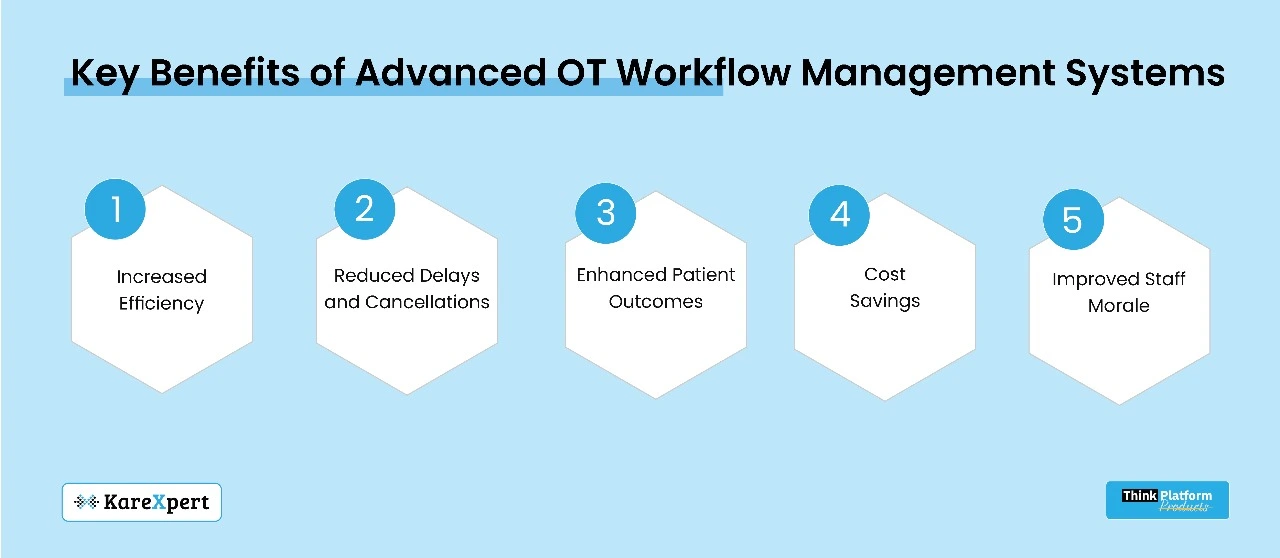Unlocking the OR: How Advanced Workflow Systems Are Revolutionizing Surgical Efficiency

In the realm of modern healthcare, the demand for efficient and streamlined operating room (OT) procedures is paramount. Operating rooms are critical environments where precision, timing, and coordination can mean the difference between successful outcomes and complications. With healthcare costs rising and patient expectations increasing, healthcare providers must find ways to optimize operating room efficiency. This is where advanced OT workflow management systems play a crucial role. These systems enhance operating room scheduling, resource allocation, and surgical team coordination, resulting in improved efficiency and patient outcomes.
Enhancing Operating Room Scheduling
Efficient scheduling is the backbone of any highly functioning operating room. Traditional scheduling methods often involve manual processes that are prone to errors, inconsistencies, and delays. Advanced OT workflow management systems offer several features to streamline the scheduling process:
1. Automated Scheduling: Advanced systems use algorithms to schedule surgeries based on factors such as surgeon availability, patient urgency, and resource availability. This automation reduces the chances of scheduling conflicts and maximizes operating room utilization.
2. Dynamic Rescheduling: In the event of emergencies or unexpected delays, these systems can dynamically reschedule procedures in real-time. This ensures that surgeries are conducted in the most efficient order, minimizing downtime.
3. Pre-Procedure Coordination: Workflow management systems facilitate pre-procedure coordination by alerting surgical teams and support staff about upcoming procedures. This ensures that everyone is prepared well in advance, reducing the likelihood of last-minute surprises.
Optimizing Resource Allocation
Operating rooms are resource-intensive environments, requiring a wide range of equipment, medical supplies, and specialized personnel. The efficient allocation of these resources is crucial for uninterrupted surgical procedures. Here’s how advanced OT workflow management systems help:
1. Inventory and Equipment Management: These systems monitor and track the availability of surgical instruments, medical supplies, and equipment. Real-time updates ensure that everything is in place before surgery begins, reducing the risk of delays due to missing items.
2. Staff Allocation: Advanced systems assign the right personnel to each procedure, ensuring that surgeons, nurses, anesthesiologists, and other critical team members are available when needed. This not only prevents staffing conflicts but also guarantees that the surgical team is well-coordinated.
3. Resource Forecasting: By analyzing historical data and procedural trends, workflow management systems can predict future resource requirements. This proactive approach helps in maintaining adequate stock levels and ensuring that all necessary resources are available for upcoming surgeries.
Improving Surgical Team Coordination
Effective communication and coordination among surgical team members are essential for successful outcomes. Advanced OT workflow management systems facilitate this by providing tools and features designed to enhance collaboration:
1. Real-Time Communication: These systems offer real-time communication platforms that allow team members to share updates, discuss procedural details, and address any issues that may arise during surgery. This immediate exchange of information ensures swift problem-solving and better decision-making.
2. Task Assignment and Tracking: Workflow management systems allocate specific tasks to team members and monitor their progress. This ensures that everyone knows their responsibilities and that tasks are completed promptly.
3. Checklists and Protocols: Implementing standardized checklists and protocols within the workflow management system helps ensure that all necessary steps are followed consistently. This reduces the risk of errors and enhances patient safety.
Key Benefits of Advanced OT Workflow Management Systems

The adoption of advanced OT workflow management systems brings numerous benefits to healthcare facilities, surgical teams, and patients alike:
1. Increased Efficiency: By automating scheduling, optimizing resource allocation, and enhancing team coordination, these systems significantly increase overall operating room efficiency. This results in the ability to conduct more procedures within the same timeframe, improving throughput.
2. Reduced Delays and Cancellations: Real-time scheduling adjustments, proactive resource management, and efficient team coordination minimize the chances of delays and cancellations. This leads to better use of operating room time and improved patient satisfaction.
3. Enhanced Patient Outcomes: Streamlined workflows and effective communication contribute to smoother surgical procedures. This, in turn, reduces the likelihood of complications, shortens recovery times, and improves patient outcomes.
4. Cost Savings: Increased efficiency translates to cost savings for healthcare facilities. By maximizing operating room utilization and reducing unnecessary expenditures on resources, hospitals can allocate their budgets more effectively.
5. Improved Staff Morale: Advanced workflow management systems reduce the stress and pressure on surgical teams by ensuring that everything is well-coordinated. This leads to a more positive work environment and higher staff morale.
Real-World Application and Success Stories
Several healthcare facilities have successfully implemented advanced OT workflow management systems, with impressive results. For instance, a major metropolitan hospital reported a 30% increase in operating room utilization after adopting such a system. Additionally, they experienced a 20% reduction in procedural delays and a 15% improvement in surgical team coordination.
Another hospital implemented a workflow management system that integrated with their existing electronic health records (EHR) system. This integration allowed for seamless data sharing, improved surgical planning, and enhanced post-operative care. The result was a significant boost in patient outcomes and overall operational efficiency.
Conclusion
In conclusion, optimizing operating room efficiency is crucial for modern healthcare facilities. Advanced OT workflow management systems offer the tools and features needed to enhance operating room scheduling, resource allocation, and surgical team coordination. The benefits of these systems are far-reaching, including increased efficiency, reduced delays, improved patient outcomes, cost savings, and enhanced staff morale.
As the healthcare landscape continues to evolve, the adoption of advanced technologies like OT workflow management systems will be pivotal in delivering high-quality care. By embracing these innovations, healthcare providers can ensure that their operating rooms are not just efficient but also equipped to handle the demands of modern surgical procedures.
Ready to revolutionize your operating room efficiency? Explore how advanced OT workflow management systems can transform your surgical operations. Contact us today to learn more and schedule a demo.
